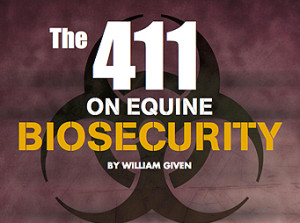The 411 On Equine Biosecurity
Click here to read the complete article40 – August/September, 2016
BY WILLIAM GIVEN
WHAT IS BIOSECURITY?
 Equine biosecurity can best be defined as the active and passive measures taken to avoid the transmission of disease causing organisms (bacteria, viruses and parasites) to a single horse or an entire herd. Biosecurity also includes the actions taken to limit the introduction of pathogens through our horses into a given geographical area where they do not yet exist. These steps include both prevention and disease containment (or biocontainment).
Equine biosecurity can best be defined as the active and passive measures taken to avoid the transmission of disease causing organisms (bacteria, viruses and parasites) to a single horse or an entire herd. Biosecurity also includes the actions taken to limit the introduction of pathogens through our horses into a given geographical area where they do not yet exist. These steps include both prevention and disease containment (or biocontainment).
As members of the horses show and performance events community, we are constantly putting our horses at risk of contracting infections from unknown sources. There are three epidemiological components effecting the introduction and spread of an equine disease that need consideration. They are the disease organism, the individual horse, and the environment.
The Pathogen
Equine disease causing organisms may be relatively mild or quite virulent. Some agents may be omnipresent on show grounds, while others will be brought to the venue by an apparently healthy horse. A horse that appears healthy but has been infected and a clinically ill horse can both shed disease causing pathogens into the environment, potentially infecting other horses at the show or event. If the event is a multi-day affair, a pathogen can potentially spread throughout the entire venue, thereby exposing every horse there to compete. Those horses which are exposed to a disease agent at an event and then return home or travel to another competition may spread the disease to healthy horses in your barn or at the next venue.
The Horse
Not all horses are equally susceptible to the acquisition of a disease. A young or senior horse will be more susceptible. Stress is key factor. Horses experience a certain level of stress at home with training and riding. When away from home, a horse will experience additional stress as a result of travel, an unfamiliar environment, new smells, new sounds, as well as the stress of exhibition and competition. These additional stresses serve to reduce a healthy horse’s immune system.
The Environment
There a number of different environmental factors that can contribute to the spread of a disease causing agent. The ambient temperature and the level of humidity will have an impact on the survival of a pathogen, and the wind direction and speed will influence the transmission of the infectious organism. The stabling environment at a show or performance event has horses in close quarters and the poor ventilation common to many venues may actually contribute to the rapid spread of a disease. If the event is a multi-day event, the possibility of exposure naturally increases.
Click here to read the complete article40 – August/September, 2016










